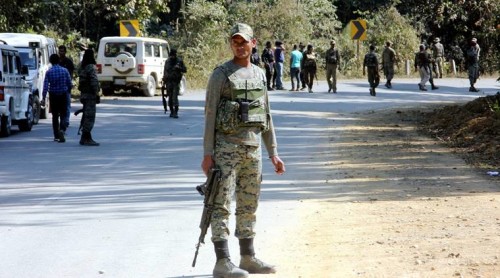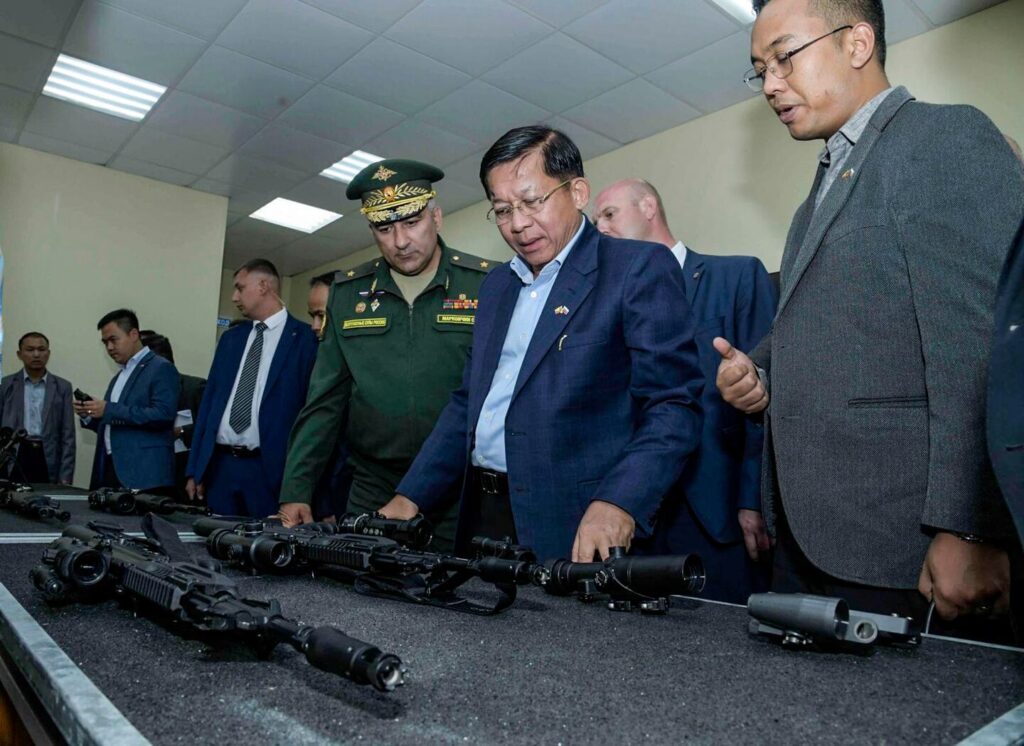MANTRAYA ANALYSIS#21: 19 FEBRUARY 2018
BIBHU PRASAD ROUTRAY
Abstract
Amid relative tranquility, little rebellions are continuing in India’s northeastern region. Headed by recalcitrant rebel leaders, some of whom have no inhibitions in aligning their ambitions with that of the anti-India policies of neighbouring countries, these movements have been responsible for the occasional acts of violence and a more persisting problem of disruption and instability. Directionless and protracted negotiations between the government and the pro-talk insurgencies have not helped. Although insurgency-related fatalities have dipped, for durable peace to return, New Delhi needs to do more.

( A security force personnel guards the site of an insurgent attack in
Assam’s Tinsukia district in January 2017, Photo courtesy: Indian Express)
In the evening of 18 February 2018, in poll-bound Meghalaya’s Garo Hills, suspected militants of the Garo National Liberation Army (GNLA) carried out a powerful improvised explosive device (IED) blast killing Jonathone Sangma, a candidate of the Nationalist Congress Party (NCP) and three others.[i] In its India’s northeasten region, such incidents of insurgent attacks are becoming rare occurring. Compared to 824 insurgency related incidents in 2014, only 308 incidents were reported in 2017. This denotes the lowest level of violence since 1997. And yet, some of the insurgencies continue to indulge in occasional acts of violence, extortion and abduction, from the safe haven in neighbouring Myanmar.
The Worst Affected
For successive years, Manipur has remained the worst insurgency affected state in the region. Even with the reduced violence and fatalities in the entire region, the state recorded 23 civilian and eight security force fatalities in 2017. This constituted over 62 percent of the total civilian fatalities and 66 percent of the security force fatalities recorded in the northeast. In 2017, 23 insurgents too were killed in different encounters further depleting the strength of the outfits. However, fatalities alone can not a true parameter to gauge the level of insurgent influence in the state.
As per official estimates more than 35 insurgent outfits operate in the state. Although many of these outfits are small and possess only minimal military strength, their domination on smaller pockets within the state remain significant. These outfits were responsible for 34 instances of bomb explosions in the state that claimed the lives of six people and injured 62 others. Altogether 68 militants surrendered further depleting the insurgent strength. The Coordination Committee (CorCom), an umbrella body of four insurgent groups of Manipur, claimed that those who surrendered were all ‘deserters’ and would be punished.
Several factors are responsible for the survival of insurgency movements in this state. Its porous borders with Myanmar continues provide easy ingress and egress facilities to the insurgents who transport weapons into the state, almost at will. The ethnic divisions between several tribes inhabiting the state and their sense of relative deprivation has always fueled conflicts. And the state’s lopsided political arrangement in which resources and political power appear to reside in the valley areas of the state which constitute only 1/3rd of its geography, dominated by the Hindu Meiteis have not taken lightly by the numerous tribes of the state. Lastly, conflict overflows from neighbouring Nagaland, where the dominant Naga insurgencies have historically claimed the Naga-inhabited areas of Manipur to be included in their imaginary homeland, the Nagalim. The counter-insurgency approach of the state has not been resolve these contradictions.
Other States
In Assam, 27 people lost their lives in 33 insurgency related incidents in 2017. They included 18 insurgents, three civilians and six security force personnel. Eight persons each died in Nagaland and Meghalaya, six insurgents were killed in Arunachal Pradesh, and no fatalities were reported from Tripura and Mizoram. Tripura’s police chief in December 2017 claimed that not a single terror group is active in the state. Given the prolonged history of insurgency in each of these states, the drastic reduction in fatalities has allowed the government to underline improved security situation.
Flag Bearers of the ‘Revolution’
Over the past years, a large number of insurgent groups have opted for negotiated settlement of their grievances with the government. Much of their desire to seek peace, however, is sourced from the unenviable position of losing their terrorist infrastructure in neighbouring countries such as Bhutan and Bangladesh and also facing the prospects of long prison terms after being arrested and handed over to the Indian authorities by Bangladesh. Nevertheless, the continued engagement of these groups has led to a significant decrease in insurgency related violence in the region.
And yet, insurgent groups headed by veteran leaders in each of these states of the region remain steadfastly attached to the idea of continuing their armed struggle against the Indian state. And the list is headed by Paresh Baruah, the legendary chief of the ULFA-Independence. Baruah is one of the founding members of the ULFA born in 1979. Although a large faction of the ULFA, known as ULFA-Pro talks has come over ground and is currently negotiating with the government, Baruah continues to defy appeals of peace by the government and heads the anti-talks faction.
Indian intelligence organisations believe that Baruah is currently based in Ruili, a Chinese town in Yunnan province and operates with help from the Chinese authorities. Most of the ULFA cadres are based in the China-Myanmar border areas and Myanmar’s Sagaing division. Occasional media reports point at the ULFA-Independence which Baruah heads attempting to carry out acts of sabotage within Assam. Although its strength has declined, ULFA-I continues to recruit within Assam and indulge in acts such as extortion and abduction.
The National Democratic Front of Bodoland (NDFB), headed by I K Songbijit remains another potent insurgent organisation in Assam. Although it has been specifically targeted by the security forces leading to a severe depletion in its cadre strength, the outfit continues to remain operate in districts like Chirang, Sonitpur, Udalguri, and Kokrajhar district.
The CorCom in Manipur remains another militant formation indulging in periodic acts of violence. It consists of four insurgent outfits and is also known to be operating out of Myanmar. Similarly, the NSCN-K in Nagaland continues to defy onslaughts of the security forces and operates out of its traditional bases in Myanmar.
Insurgent Strategies
In the morning of 24 January 2018, suspected insurgents, who remain unidentified till date, detonated an explosion damaging two vehicles of the Indian Army in Arunachal Pradesh’s Changlang district.[ii] The Army team was returning from an overnight counter-insurgency operation in an attempt to secure the Republic Day celebrations on 26 January. The celebrations went off peacefully even though suspected ULFA-I cadres carried out three explosions in Assam’s Tinsukia district without causing any casualty.[iii] Faced with the prospect of a significant weakening of their popular support and military prowess, the insurgent activities, in the past years, appear to have adopted a range of tactics not just to survive, but continue to pose a threat to the security forces.
Jointness: Although alliance formation among insurgent outfits is not a new phenomenon, in the past years many existing outfits have demonstrated a tendency to operate jointly and coordinate their activities. The ULFA-I, CorCom and the NSCN-K are part of a broader alliance of non-ceasefire signatory insurgent groups in the region that have increasingly conducted joint operations and exploited the porous border with Myanmar. In 2015, the NSCN-K and the ULFA-I along with the Kamtapur Liberation Organisation (KLO), which operates in North Bengal and the National Democratic Front of Bodoland (NDFB), which operates in Assam, formed the United National Liberation Front of Western South East Asia (UNLFWS). Although many of their doctrinal objectives are different, an anti-India outlook unites the outfits. Further, a level of jointness addresses the issues of operational weakness, which has affected insurgencies across the region. Both ULFA and CORCOM continue to coordinate their operations and have resolved to carry out joint operations against the security forces. In 2017, both had carried out ‘Operation Barak’, a moderately publicized joint operation. The UNLFWS has been responsible for a number of spectacular attacks on the security forces including the killing of 18 army personnel in Manipur’s Chandel district in June 2015.
Cross border operation: The insurgent outfits have increasingly shifted their strategies towards the conduct of cross-border strikes in areas adjacent to the international border. Declining support base within their respective states and increasing domination exercised by the security forces is making the task of carrying out operations deep inside the states difficult. As a result, inter-state borders and districts lying along India’s borders with Myanmar are increasingly witnessing more attacks. As a result, seven districts including Arunachal Pradesh’s Tirap, Changlang and Longding, Assam’s Tinsukia, Manipur’s Chandel, and Nagaland’s Mon and Tuensang witness bulk of the major insurgent attacks. Districts bordering Myanmar allow the insurgents easy egress after carrying out the attacks. A security official admitted in May 2017, “The biggest advantage of these districts is their proximity to the NSCN-K-controlled areas of Myanmar and their highly difficult terrain, which makes patrolling a difficult task for security agencies.” In addition, lack of coordination among the security forces deployed in different states along the inter-state border areas is also being exploited by the insurgents.
IED attacks: Explosion of IEDs is becoming a predominant mode of attack on the security forces. This underline the importance attached by the insurgents to minimize cadre losses. Most of these IEDs till now (barring the one which was used on 18 February 2018 in Meghalaya) have remained crude and hence, their impact low scale. However, with technological upgradation, IEDs have the potential of emerging as a lethal weapon, especially in the challenging geography of the northeast.
Recruitment: The total cadre strength of the northeastern insurgencies operating out of Myanmar is estimated to be in the range of 2500. Assam Police confirms that ULFA-I has been able to successfully recruit youths from various districts. Although the scale of such recruitment is not alarming, this steady flow of new cadres prepares the outfit to make up for the neutralized cadres. As a result, the cadre strength of the outfit continues to be in the ‘hundreds’ in spite of security force successes. Similar low scale, and yet successful cadre recruitment has continued to take place in Manipur and Nagaland. The split within the NSCN-K and an anticipated internal revolt against the new leadership following the death of its leader K K Khaplang notwithstanding, the outfit maintains at least 1000 cadres.
State Response
On 3 February, Prime Minister Narendra Modi inaugurated the two-day global investment summit, titled “Advantage Assam” in Assam’s capital Guwahati.[iv] Attended by business tycoons, the Assam government used the summit to seek investment in 12 sectors and also to project Guwahati as a destination for doing business with south-east Asian countries. Decline of violence in the region and operational weakness of the existing insurgencies has indeed allowed the state governments and New Delhi to initiate a range of development initiatives in the strategically important region. Northeast is a crucial link between India and Southeast Asia and an important component of its Act East policy. To that extent, official strategy to further stabilise the region is multi-pillared.
First, successful negotiations with the insurgents leading to the conclusion of agreements remain an important strategy. However, most of these negotiations have continued without an end, primarily because both parties have been unsure about what beyond a few development packages for the state can be granted to the specific states. Negotiations with the NSCN-IM for instance have been going on since 1997. In August 2015, the BJP government in New Delhi announced a breakthrough to the negotiations, although in the end the deal turned out to be only a framework agreement on future talks. Little progress has been achieved since then, although media reports have periodically indicated conflicting reports on the outfit agreeing to a federal arrangement with New Delhi in return for measures like an independent flag and a constitution. However, a final accord is not anywhere near conclusion. Such negotiations have led to a curious state of affairs in the respective states in two important ways. Firstly, this has allowed cadres within such outfits to be involved in criminal and extra-legal activities such as extortion and abduction. Secondly, frustrated by the prevailing situation without an end in sight, some of these cadres, although only a very small number till now, have rejoined the active insurgencies.
Second, military operations by the Indian army, state police and central paramilitary forces against the remnants of insurgencies have continued in different states of the region, leading to killings, and arrests of insurgents. Between 2012 and 2016, at least 777 insurgents were killed, 8893 were arrested and 3176 surrendered to the authorities. On an average, numerical strength of insurgent outfits was depleted by 2569 cadres per year. However, the fact that majority of the insurgents belonging to the major outfits like the ULFA, NSCN-K, NDFB, and the CorCom group are based in Myanmar, such operations have been minimal in their effectiveness. In the past three years, Indian army reportedly has undertaken multiple anti-insurgency operations inside Myanmar territory. Some of these operations, for instance the one in June 2015, were retaliatory in nature after insurgents ambushed security force personnel within Indian territory and then retreated into Myanmar. The actual impact of such operations is unknown although in 2015 the Indian Army claimed to have inflicted serious damages on the NSCN-K establishment in Myanmar. The last such surgical strike along the Indo-Myanmar border was reported in September 2017.
Third, while some of the surgical forays by the Indian Army into the ungoverned spaces in Myanmar could have been unilateral in the past, enhancing bilateral security relations with Myanmar has been New Delhi’s attempt to deal with the remnants of northeastern insurgencies based in Myanmar. In the recent years, New Delhi has followed up the high-level visits of political leaders and security officials to Myanmar with provision of military hardware, road building equipment, and sharing of intelligence. Although some of these measures may not have led to actual cooperation from Myanmar, New Delhi believes that active engagement with Myanmar is the key to neutralize the insurgencies finding safe haven in that country.
Fourth, New Delhi is increasingly being led to believe that China is renewing its policy of assisting the northeastern insurgencies. On 27 January 2018, Chairman of the Joint Intelligence Committee (JIC) R N Ravi, who is New Delhi’s interlocutor for Naga peace talks said that “mischievous campaigns” have been launched by foreign forces from outside and inside India to pose hurdles in the way of peace talks. The location of Paresh Baruah in Ruili, his repeated pro-Chinese statements including the one in March 2017 in which he opposed the visit of Dalai Lama to the northeast, confessions made by arrested ULFA cadres, and some of the recent activities of ULFA cadres in Assam possibly indicate that the outfit’s agenda could have been dictated by external agencies. For example, on 15 January 2018, a ULFA-I linkman working as a local journalist was arrested on charges of passing on information to the outfit about the Air Force station in Assam’s Chabua. Intelligence agencies suspect that such information in being collected by the ULFA-I for the Chinese agencies. New Delhi believes that any resumption of active assistance by China to these outfits would infuse fresh lives into them. However, it is unsure how to counter this move by the Chinese.
And finally, taking advantage of the improved security situation, New Delhi is reportedly considering reducing the footprints of the security force personnel in the northeast. The Home Ministry is proposing to hold a security audit to assess the actual number of security forces needed to remain deployed in the region and implement a plan to reduce the number of Central Armed Police Personnel. The move may take into consideration the proposal of the affected states to step up the presence of the central intelligence and security force personnel in the seven most affected districts of Assam, Manipur, Nagaland, and Arunachal Pradesh. There is, however, no proposal to reduce the number of army personnel in the region, although human rights campaigns have targeted the abuses by the army personnel and demanded the withdrawal of the controversial Armed Forces (Special Powers) Act that promotes an alleged culture of impunity.
Prognosis
The persisting motivation behind violence by active insurgencies is hard to decipher. Notwithstanding their capacities to carry out odd attacks on the security forces, they are unlikely to ever pose an existential threat to the Indian state, let alone carve out independent territorial space. However, such indulgence in violence and pursuance of an unrealisable dream provides them with other benefits such as extortion. Curiously, they are also willing to align their ‘nationalist’ ambitions with the anti-India policies of neighbouring countries. Hostile geography, blow hot and blow cold policy of the government, absence of governance, and lack of adequate cooperation from Myanmar aids them at the moment. Alienation among the population and ethnic divide add to their relevance. It is indeed a complex state of affairs and even with the operational weaknesses, insurgencies are likely to pose a serious and continued challenge. New Delhi’s strategies for the region need to factor in the need for responsive governance, inclusive development, and participation of the marginalized rather than relying solely on protracted and directionless negotiations and disproportionate use of force.
[i] “NCP Candidate, Ex-GNLA Rebel Among Four Killed In IED Blast”, Shillong Times, 19 February 2018, http://www.theshillongtimes.com/2018/02/19/ncp-candidate-ex-gnla-rebel-among-four-killed-in-ied-blast/
[ii] “Insurgents trigger blast under army vehicles in Namsai”, Shillong Times, 24 January 2018, http://www.theshillongtimes.com/2018/01/24/insurgents-trigger-blast-under-army-vehicles-in-namsai/
[iii] “Communal clashes in UP, blasts in Assam mar 69th Republic Day celebrations; Kashmir remains peaceful”, First Post, 26 January 2018, http://www.firstpost.com/india/communal-clashes-in-up-blasts-in-assam-mar-69th-republic-day-celebrations-kashmir-remains-peaceful-4321615.html
[iv] Prasanta Mazumdar, “Guwahati diary: Assam capital gears up for two-day global investment summit”, New Indian Express, 29 January 2018, http://www.newindianexpress.com/nation/2018/jan/29/guwahati-diary-assam-capital-gears-up-for-two-day-global-investment-summit-1764859.html
(Bibhu Prasad Routray is the Director of MISS. This analysis has been published under Mantraya’s ongoing “Mapping Terror and Insurgent Networks” Project. All Mantraya publications are peer-reviewed.)




